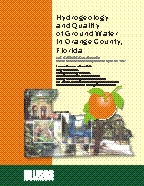

|
WRIR 03-4257
Prepared in cooperation with the:
City of Orlando, Orange County Utilities, Orlando Utilities Commission, Reedy Creek Improvement District,
St. Johns Water Management District, and the South Florida Water Management District
2004
Hydrogeology and Quality of
Ground Water in Orange County, Florida
By James C. Adamski and Edward R. German
Adobe® PDF Reader® program is available for free from Adobe.
 |
|
Suggested Citation: Adamski, J.C., and German, E.R., 2004, Hydrogeology and Quality of Ground Water in Orange County, Florida: U.S. Geological Survey Water-Resources Investigations Report 03-4257, 88 p., plus 4 appendixes.
ABSTRACT Ground water is the main source of water supply in central Florida and is critical for aquatic habitats and human consumption. To provide a better understanding for the conservation, development, and management of the water resources of Orange County, Florida, a study of the hydrogeologic framework, water budget, and ground-water quality characteristics was conducted from 1998 through 2002. The study also included extensive analyses of the surface-water resources, published as a separate report.
An increase in population from about 264,000 in 1960 to 896,000 in 2000 and subsequent urban growth throughout this region has been accompanied by a substantial increase in water use. Total ground-water use in Orange County increased from about 82 million gallons per day in 1965 to about 287 million gallons per day in 2000. The hydrogeology of Orange County consists of three major hydrogeologic units: the surficial aquifer system, the intermediate confining unit, and the Floridan aquifer system. Data were compiled from 634 sites to construct hydrogeologic maps and sections of Orange County. Water-level elevations measured in 23 wells tapping the surficial aquifer system ranged from about 10.6 feet in eastern Orange County to 123.8 feet above NGVD 29 in northwestern Orange County from March 2000 through September 2001. Water levels also were measured in 14 wells tapping the Upper Floridan aquifer. Water levels fluctuate over time from seasonal and annual variations in rainfall; however, water levels in a number of wells tapping the Upper Floridan aquifer have declined over time. Withdrawal of ground water from the aquifers by pumping probably is causing the declines because the average annual precipitation rate has not changed substantially in central Florida since the 1930s, although yearly rates can vary. A generalized water budget was computed for Orange County from 1991 to 2000. Average rates for the 10-year period for the following budget components were computed based on reported measurements or estimates: precipitation was 53 inches per year (in/yr), runoff was 11 in/yr, spring discharge was 2 in/yr, and net lateral subsurface outflow and exported water was 1 in/yr. Evapotranspiration was 39 in/yr, which was calculated as the residual of the water-budget analysis, assuming changes in storage were negligible.
Water-quality samples were collected from April 1999 through May 2001 from a total of 26 wells tapping the surficial aquifer system, 1 well tapping the intermediate confining unit, 24 wells tapping the Upper Floridan aquifer, 2 springs issuing from the Upper Floridan aquifer, and 8 wells tapping the Lower Floridan aquifer. These data were supplemented with existing water-quality data collected by the U.S. Geological Survey and St. Johns River Water Management District.
Concentrations of total dissolved solids, sulfate, and chloride in samples from the surficial aquifer system generally were low. Concentrations of nitrate were higher in samples from the surficial aquifer system than in samples from the Upper Floridan or Lower Floridan aquifers, probably as a result of agricultural and residential land use. Water type throughout most of the Upper Floridan and Lower Floridan aquifers was calcium or calcium-magnesium bicarbonate, probably as a result of dissolution of the carbonate rocks. Water type in both the surficial and Floridan aquifer systems in eastern Orange County is sodium chloride. Concentrations of total dissolved solids, sulfate, and chloride in the aquifers increase toward eastern Orange County. Data from 16 of 24 wells in eastern Orange County with long-term water-quality records indicated distinct increases in concentrations of chloride over time. The increases probably are related to withdrawal of ground water at the Cocoa well field, causing an upwelling of deeper, more saline water. The most commonly detected trace elements were aluminum, barium, boron, iron, manganese, and strontium. In addition, arsenic was detected in 12 of 59 samples, and selenium was detected in 19 of 58 samples. Concentrations generally were low; no samples had concentrations that exceeded any of the Maximum Contaminant Levels. Radon was detected in all ground-water samples in concentrations ranging from 56 to 14,700 picoCuries per liter.
Pesticide compounds were detected in low concentrations in 8 of 16 ground-water samples from the surficial aquifer system and in 2 of 14 samples from the Upper Floridan aquifer. The most commonly detected compounds were atrazine and its degradate, deethyl atrazine. Pesticides were present in shallow ground water primarily in urban areas around metropolitan Orlando. The source of pesticide compounds in ground-water samples probably is lawn-care and other household products containing pesticides. Pesticide concentrations did not exceed any Maximum Contaminant Levels.
Data from this study indicate that ground water is an abundant resource in Orange County, Florida. The quality of ground water generally is within the Primary and Secondary Drinking Water Regulations established by the U.S. Environmental Protection Agency; however, water-quality samples for this study were collected under drought conditions. Additional study to document water quality during various hydrologic conditions would be beneficial to understanding the occurrence and distribution of constituents such as pesticides.
| AccessibilityFOIAPrivacyPolicies and Notices | |
 |
|